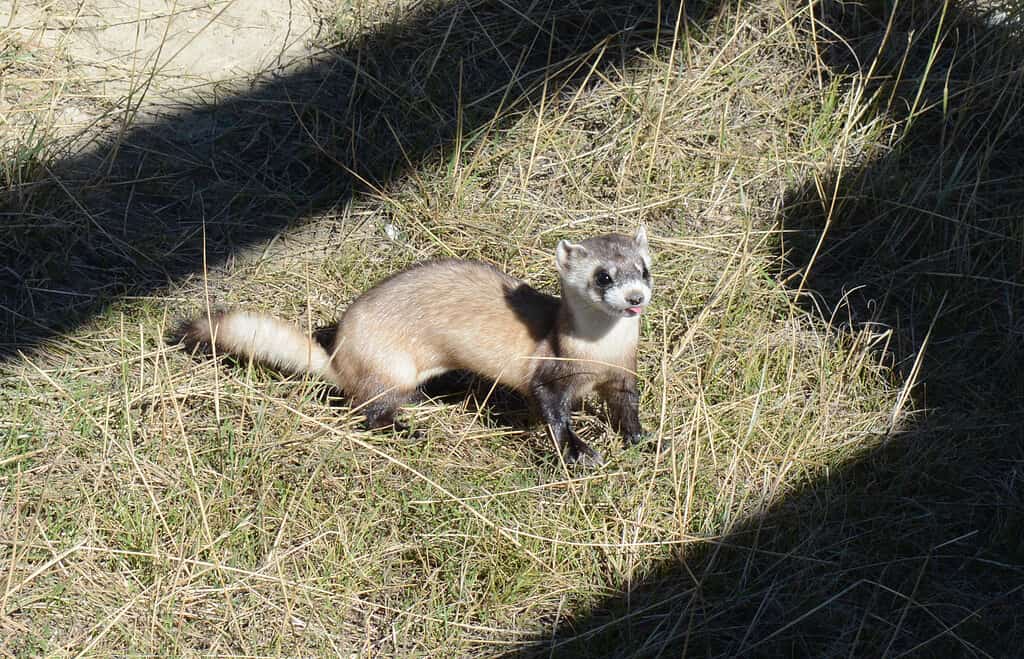Let’s be honest, black-footed ferrets are among the world’s most adorable mammals. They have been putting smiles on the faces of mankind for hundreds of years with their expressive faces and quirky antics. However, black-footed ferret populations have been on the decline for some time now. In fact, experts are concerned that someday they will disappear altogether. Let’s discuss how many black-footed ferrets are left in the world today and explore whether or not this beloved creature is classified as endangered.
Black Footed Ferrets: A Brief Overview

These animals often take up residence in
prairie dog
burrows.
©USFWS Mountain-Prairie – Black-footed Ferret Kit / CC BY 2.0 – License
Black-footed ferrets are small mammals that are native to North America. They were once found all throughout this land mass from Canada down to Mexico. However, they have been increasingly scarce throughout the years. At maturity, black-footed ferrets weigh about two pounds and grow to be 20 inches long. Their diet is primarily comprised of prairie dogs. However, these animals will eat other small rodents such as mice and rats if they can get their hands on them.
Black-footed ferrets reach sexual maturity around 12 months of age, after which many begin breeding. This occurs in the spring, typically during March and April. After roughly seven weeks of pregnancy, they will deliver a litter of about three offspring. The mother will care for them until they begin to venture out on their own. On average, black-footed ferrets live to be about four or five years old in the wild. However, some live nearly double that in captivity.
What Is the Conservation Status of Black-Footed Ferrets?

Black-footed ferrets belong to the family
Mustelidae.
©Piskova Photo/Shutterstock.com
Unfortunately, black-footed ferrets are presently endangered. This is due in part to habitat loss, predation, decreasing food availability, and human interference. At one point, seeing one of these mammals was so uncommon that experts once believed that black-footed ferrets were extinct altogether. Thankfully, this wasn’t the case and these mammals popped up again in 1981 in the state of Wyoming. That being said, there aren’t many black-footed ferrets left in the wild today. According to World Wildlife, “Captive breeding, reintroductions, habitat protection, and cloning have helped restore them to over 300 animals in the wild. Although great strides have been made to recover the black-footed ferret, habitat loss and disease are their key threats. Biologists estimate that there should be 3,000 adult ferrets in the wild to successfully recover this endangered species.”
How Can We Help Black-Footed Ferrets Recover?

Black-footed ferrets are commonly predated by large birds such as eagles, hawks, or owls
©Yasmins world/Shutterstock.com
Although conservationists are putting an incredible amount of effort into restoring black-footed ferret populations, they could not do so without the help of the general public as well. If you feel called to help this cause, there are several ways you can do your part. Do your best to keep pollution to a minimum and avoid using any sort of rodent poison in your garden or yard. This will help ensure that these animals have access to ample food sources. In addition, you can protest urbanization or construction that overlaps with the black-footed ferret’s natural habitat. In some cases, certain individuals may even consider starting a career in wildlife conservation. This is a noble cause, and this field needs as many impassioned hearts and brilliant minds as it can get.
To many, the situation might appear to be at a dire point now. However, experts have hope that black-footed ferret populations still have the chance of recovering in the future. As we stated earlier, this animal was once thought to be completely extinct. Since then, they have come back from the brink, and although their numbers are still small, they are increasing slowly.
The photo featured at the top of this post is © Yasmins world/Shutterstock.com
Thank you for reading! Have some feedback for us? Contact the AZ Animals editorial team.






